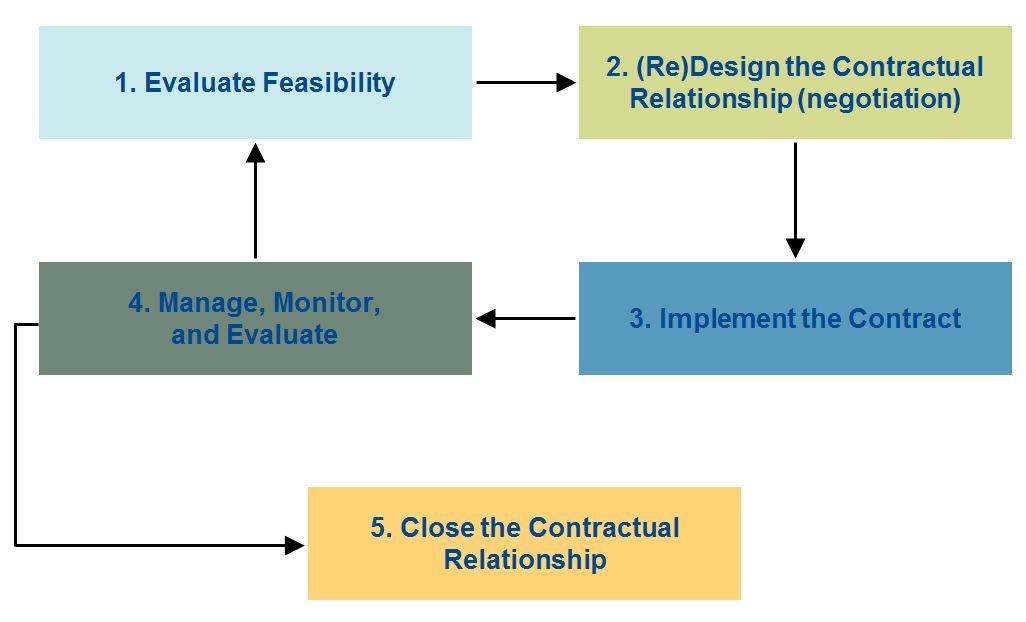The Contracting Lifecycle
Contracts follow a predictable cycle from their inception until their end, as illustrated by the five-stage framework shown below. Each contract (or contracting opportunity) for family planning services can be evaluated at each phase of the contracting lifecycle. The focus and activities of the SDO with respect to a contract will differ depending on which stage of the lifecycle applies.

Adapted from Tayag et al., 2014
Stage One: Evaluate Feasibility
In the first stage of the contracting lifecycle, stakeholders evaluate the feasibility of entering into a contractual arrangement for family planning services. During this stage, SDOs should take stock of relevant conditions, some of which are external and others that are internal to their organization. Information gathered should help the SDO evaluate the compatibility of the contracting opportunity with the SDO’s client base and the services it offers as well as its readiness to comply with the provisions of the potential contract (accreditation requirements, capacity to serve expected clients, and so on).
This same approach to evaluate feasibility can be applied iteratively during the operational life of a contract. For example, ideas to improve a program based on the results of monitoring and evaluation during Stage 4 of the contracting lifecycle will trigger a new round of feasibility assessment and a return to Stage 1. In turn, this may then lead to the changes in the underlying contractual relationship (Stage 2), and so on.
Stage Two: (Re)Design the Contractual Relationship (negotiation)
To secure a new or renewed contract for family planning services, the SDO and the purchaser negotiate and agree upon the scope of services, including performance standards and reporting requirements. A key feature of the contract evaluation and design concerns the payment arrangement, including the method and amount of payment for services, any assumption of financial risk, incentives and disincentives, and so on.
Stage Three: Implement the Contract
To implement contracts to provide family planning services, SDOs must train staff to implement new monitoring, reporting, and billing processes and ensure that they have adequate resources, including the staff, supplies, and equipment required to provide the services. Other operational components are established, such as a dispute resolution mechanism for clients and a communication plan to define roles and responsibilities between contracting parties to exchange information related to the contract.
Stage Four: Manage, Monitor, and Evaluate
SDOs can expect service contracts to be monitored by purchasers to assess the extent to which the SDO’s services are being delivered with adequate quality and efficiency. In addition, purchasers will assess that other terms of the agreement are carried out satisfactorily. For example, monitoring can include the number of clients served, client satisfaction, periodic assessments of the quality of service provision, and accuracy of documentation and billing.
SDOs will want to monitor purchasers’ performance under the terms of an agreement. For example, it is critical to monitor that payments are timely and accurate, as often cash flow under contracts—particularly those with governments—may be delayed or irregular. SDOs should monitor in-force contracts regularly (for example, monthly) to assess the timeliness and adequacy of payments under the contract and the degree of compliance with its financial terms by both parties to the agreement. The SDO must continuously evaluate whether ongoing delivery of the contracted services is sustainable under the terms of the agreement. Regular meetings (for example, quarterly) with purchaser partners can help address issues or challenges that can arise during the life of the contract.
SDOs and purchasers use the results of monitoring and evaluation to assess their performance under a contract. Based on the performance of both parties, the contracting lifecycle may be renewed or come to an end.
Stage Five: Close the Contractual Relationship
Termination, or closure of a contract, is the last stage of the contracting lifecycle. Termination occurs when action is taken by one or more parties to end a contract before its full performance—usually earlier than planned and often after other efforts to address challenges under the agreement have failed.
Closure of a contract refers to the completion of the obligations stated within the terms of the contract on or before the designated effective period ends. A contract should explicitly outline provisions and a process for termination and closure, which all parties agree to follow, to minimize disruption and costs to end the contract. It is important to consider continuity of service for clients, including proper notification and communication of changes, which may affect clients as a result of contract termination. SDOs, in particular, should evaluate their obligations when negotiating terms of a contract, in the event of termination by either party. An important consideration is the length of time the SDO is obligated to continue service delivery if a contract is terminated.